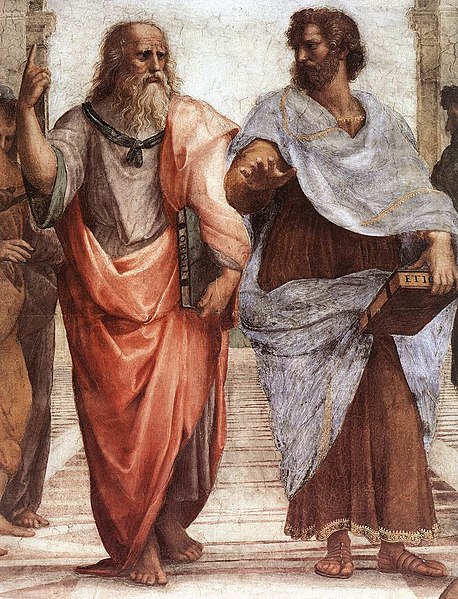Aesthetic(s)
1. "Appreciation or criticism of the beautiful. The term refers to a branch of Western philosophy concerned primarily with the fine arts, although it may also be used in the context of the appreciation of natural beauty." (Getty Art & Architecture Thesaurus Online)
2. "The philosophical study of beauty and taste. It is closely related to the philosophy of art, which is concerned with the nature of art and the concepts in terms of which individual works of art are interpreted and evaluated." (Encyclopedia Britannica)
 truth: The Greek philosopher Plato (mid-late 420s to 348/347 BCE) asserted that art is only a "shallow imitation" of the visual presentation of an Eternal Form, that "served only to draw humans far away from the Truth. This ... concept of ‘Truth’ refers to the idea that the purest existence of any given thing lies not in the physical ... thing itself, but rather in its invisible and eternal ‘Form’" (Ferrer). Plato's student, Aristotle, however, "believed that objects contain their own eternal truths different in nature from their universal Forms. ... Aristotle invites us to realize that although artistic depictions may be based on an “outward appearance”, these depictions are a means to communicate an artist’s “inward” experience of the physical world." He believed that "the truth resides on earth and within the human anima, or soul, without having to look to Platonic Forms. Art is our tool to relate this truth" (Ferrer). According to contemporary aesthetics, art history, and media theory professor Boris Groys, art is a medium of truth. He writes that the idea of truth is "central to the existence and survival of art because if art cannot be a medium of truth then art is only a matter of taste," and the "art spectator becomes more important than the art producer" (Groys). In your estimation, what is the relationship between Truth and Art?
truth: The Greek philosopher Plato (mid-late 420s to 348/347 BCE) asserted that art is only a "shallow imitation" of the visual presentation of an Eternal Form, that "served only to draw humans far away from the Truth. This ... concept of ‘Truth’ refers to the idea that the purest existence of any given thing lies not in the physical ... thing itself, but rather in its invisible and eternal ‘Form’" (Ferrer). Plato's student, Aristotle, however, "believed that objects contain their own eternal truths different in nature from their universal Forms. ... Aristotle invites us to realize that although artistic depictions may be based on an “outward appearance”, these depictions are a means to communicate an artist’s “inward” experience of the physical world." He believed that "the truth resides on earth and within the human anima, or soul, without having to look to Platonic Forms. Art is our tool to relate this truth" (Ferrer). According to contemporary aesthetics, art history, and media theory professor Boris Groys, art is a medium of truth. He writes that the idea of truth is "central to the existence and survival of art because if art cannot be a medium of truth then art is only a matter of taste," and the "art spectator becomes more important than the art producer" (Groys). In your estimation, what is the relationship between Truth and Art?Works Cited
“Beauty.” Lexico, Powered by Oxford, 17 June 2019, https://www.lexico.com/en/definition/beauty.
"Epistemology." Lexico, Powered by Oxford, 17 June 2019, https://www.lexico.com/en/definition/epistemology.
Ferrer, Emma. “The Truth in Art and the Art in Truth.” The Florence Academy of Art, https://www.florenceacademyofart.com/the-truth-in-art-and-the-art-in-truth/. Accessed 19 June 2019.
Groys, Boris. “The Truth of Art.” e-flux, no. 71, March 2016, https://www.e-flux.com/journal/71/60513/the-truth-of-art/. Accessed 19 June 2019.
"Judgement." Lexico, Powered by Oxford, 17 June 2019, https://www.lexico.com/en/definition/judgement.
"Phenomenology." Lexico, Powered by Oxford, 17 June 2019, https://www.lexico.com/en/definition/phenomenology.
"Sublime." Lexico, Powered by Oxford, 17 June 2019, https://www.lexico.com/en/definition/sublime.
"Taste." Lexico, Powered by Oxford, 17 June 2019, https://www.lexico.com/en/definition/taste.


 Copyright "is a form of protection grounded in the U.S. Constitution and granted by law for original works of authorship fixed in a tangible medium of expression. Copyright covers both published and unpublished works." Learn more here.
Copyright "is a form of protection grounded in the U.S. Constitution and granted by law for original works of authorship fixed in a tangible medium of expression. Copyright covers both published and unpublished works." Learn more here.
Fair Use allows "the unlicensed use of copyright-protected works in certain circumstances." Learn more here.
Creative Commons licenses make creative works "freely available for legal use, sharing, repurposing, and remixing" by "any member of the public." The CC Search search engine lets you "search for free content in the public domain and under Creative Commons licenses. Learn more about CC licenses here."
More information:
The MLA, Chicago, and Turabian citation styles may be used in writing about art. Check your syllabus or contact your professor to find out which style they prefer.
Quick guides to citing images:
College Art Association Guidelines regarding Fair Use and Copyright: